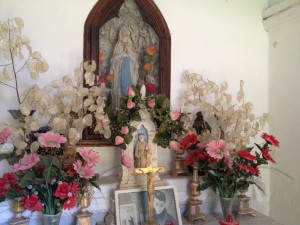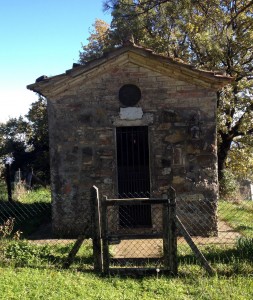Today I needed to run some errands and get out into the countryside, so I called Mauro Cardetti, our family mechanic for years, to see if I could borrow a car for a little while.
—Certo! he said. Sure! I walked down to his shop and he awaited me with a dusty little red Twingo, a car that looks a lot like a boxer, the dog. I walked around his shop checking out the vast collection of posters of naked women while he ordered his grandson to check the oil. He mumbled as he put air in the tires.
When they finished he turned to me.
—Non e` una Ferrari— he said, opening the door for me and smiling —ma va. It’s not a Ferrari, but it works. I love Mauro.
The countryside today was miraculous, beyond words. To cry for. The sky was crystalline blue all the way to infinity, and I set out for Le Piazze. I will never be able to find the right words to describe the tapestry of colors and textures of this landscape. Interestingly, watching the undulations and slopes of the land here I think more and more frequently of analogies involving water, of the earth rolling like huge oceanic waves. Today every tree, every hill, field, patch of grass, branch of olive tree, shone distinctly, tersely. The colors were spectacular, moving more toward the dark yellows now, and the grapevines are turning deep red.
I stopped to buy some wine, and while Alessandro was preparing my case, a girl I had not seen in thirty years walked into the cantina. Her name is Lucia and when we first moved here she lived in Patargnone, a little borgo in the country, nothing more than a little group of clustered houses up on the hill, where we lived while our house was being restored. Her father and my mother, an odd combination now that I think of it, took turns carpooling us into town. I don’t think he trusted my mom the first few times, but he got used to it. Lucia looks just like her mother did then, with jet black hair and black eyes, rosy cheeks, a little pudgy, with a sweet girl-like smile, the same one she had as a little girl. We exchanged news for a few minutes—she has an 18-year-old son and an agriturismo up on the mountain.
—Vieni a trovarmi!!— she said. Come see me, and waved.
From Le Piazze I drove to Fighine, a hamlet surrounding a castle high up on Monte Cetona. I had not been there in decades—I have been there perhaps only twice in my lifetime and never in weather like today. At every turn as I rose up the mountain on this curvy road another distant set of scenery opened before me, another little town on the horizon, another set of hills, farther and farther away, until I could see mountains I had never seen from here, their highest peaks pink and topped by snow. To my side Monte Cetona sat like a big giant, its shoulders and back rolling in sliding slopes densely vegetated, thick with dark trees and bathed in sunlight, opening, as you descend, to fields of olive trees and rows and rows of grapevines. When you get up to the height of Fighine, the top of the mountain, la cima—the top, as it is called here—bristly with pines and other mountainous trees, stands almost to your side, like you could wave open your left arm and hit the cross with the backside of your hand. It is right there, and magnificent.
I was disappointed to learn that Fighine is entirely privately owned and there is no access to the castle or for that matter any lookout. Carlo Baglioni’s workers are up there restoring another portion of the town, which is my only hope of seeing it. No, signora, they said, there is no place to look. I am momentarily outraged by the private ownership of castles, but then I laugh thinking that they always have been private. I see two guys doing yard work inside the castle gate and I walk towards them. They turn off their machines. So’ Inglesi, they tell me. The owners are English. Umph, I say. We laugh. Beati loro! Lucky them.
I loved the view driving back down, though, and headed to another little hamlet nearby, Camporsevoli, on an adjacent slope of Monte Cetona, a tiny group of houses surrounding a church and another small castle or fort of some kind, another place I had not visited in decades. The town was deserted—I saw not a person or a cat—but immaculately and recently restored and preserved.
On the outskirts of the village I stopped to take a picture. A man was picking olives in a field below me. He stopped his work and came towards me. He told me a family owns the whole town of Camporsevoli, first the parents, then their children, a brother and a sister. They bought it all—it was all falling apart. They do good work, he said, they keep it in good shape, clean. They are restoring a farmhouse down there, too, he said pointing to a field above. It takes a lot of money to pay the taxes and do all that, he said. Not everybody can do that. I reconsider what I thought about Fighine.
I think back to when Aldo and Anna Lanari owned the Rocca in Cetona, the castle that towers over the town, its signature monument. The Lanaris had just bought the Rocca and, high-mindedly, they decided that they wanted to give the people of Cetona a chance to celebrate the property and see it, so they decided to open it to the public twice a year or something like that. They put out beautiful food and generous drink and let people roam through the carefully manicured hedges and the rose gardens and take in the spectacular view of the countryside and the town below. Town folk came, hoarded the food like they had not eaten for a month, drank all the wine, threw garbage on the paths, and talked trash behind the Lanari’s back for trying to do something nice. Never again, said Anna. Never again. I can see why castles are private.
While I am talking with the man I notice a tiny chapel set off the road, a little matchbox of a building, stone, surrounded by a simple wooden fence and a metal gate in a patch of brilliant green grass. 1916, it says on a plaque.
I ask him, what is this? It is beautiful.
—E` una cappella votiva, said the man. L’hanno costruita durante la guerra. Ci andavano a pregare per i persi in guerra, i feriti. Ci pregavano. Quando ancora la gente ci credeva. Adesso non tanto. It is a votive chapel. They built it during World War I so people could go there and pray for the lost and disappeared. They prayed there, when people still prayed. When people still believed. Now not so much.
He offered to get the key to the chapel from his mother, and he let me inside. It is lovely, plain but with many little lights, pictures of the Virgin Mary, and plastic flowers. I thought of what it must have been like there during World War I, in the middle of nowhere, high up on the mountain, with no news, no information, praying for a son who has gone, a husband. 1916.
—L’anziani, i giovani l’avranno costruita— the man said. Old people and children must have built it, people who had not gone to war, he said.
—Chissa`. Who knows.
I comment on the weather, the beauty of the day, and the peace. He smiles.
—Eh si, qui e` diverso. Qui se senti passare una macchina e` strano, he said. Yes, here it is different. If you hear a car it is strange.
And that is a world I like.
Sybil Fix©2013


